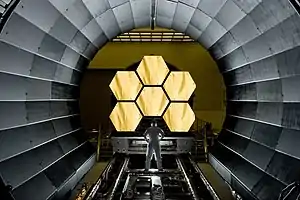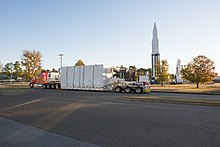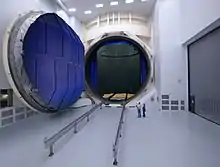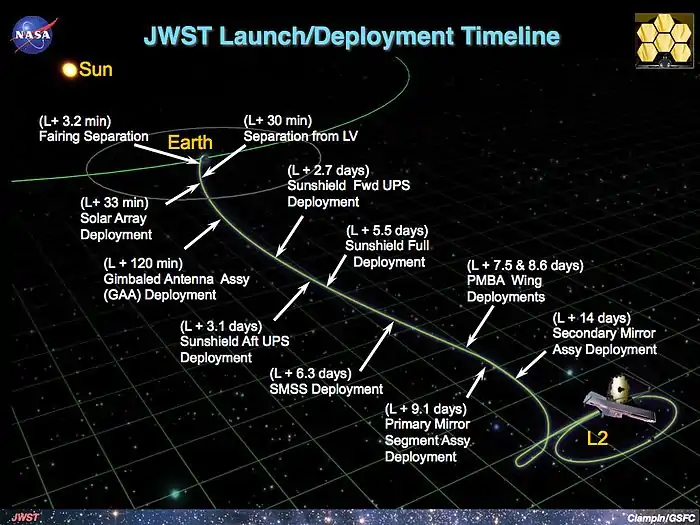Timeline of the James Webb Space Telescope
The James Webb Space Telescope is an international 21st century space observatory scheduled to be launched on October 31, 2021. It is intended to be a premier observatory of the 2020s, combining the largest mirror yet on a near-infrared space telescope with a suite of technologically advanced instruments from around the world.[1]

.jpg.webp)


.jpg.webp)
The telescope is designed to last at least five and a half years (six months calibration plus five years science operations), but with a goal of ten years.[2] The limiting factor is expected to be fuel to maintain its halo orbit, of which there is enough for at least ten years.[2]
JWST is expected to cost at least $8.8 billion, including design, construction, and five years of operations (does not include extended mission funding) or International contributions.[3][4] Its likely peak year for funding was probably 2014, when the project used more than $650 million.[3]
Timeline of selected events
- 1996, Next Generation Space Telescope initiated.[5]
- 2000, NEXUS cancelled (JWST technology demo).[6][7]
- 2002, $824.8 million prime contract for NGST awarded to TRW.[8]
- September 2002, NGST named James Webb Space Telescope.[5][1]
- January 2007, 9/10 technology development items pass non-advocate review.[9]
- April 2010, technical part of Mission Critical Design Review (MCDR) passes.[10]
- July 2011, James Webb project threatened with cancellation.[11][12][13][14]
- November 2011, JWST survives cancellation attempt.[15]
- 2012, MIRI instrument hand-off.[16]
- March 2013; FGS/NIRISS installed in ISIM.[17]
- July 4, 2013; MIRI installed in ISIM.[18]
- March 2014, NIRCam installed in ISIM [19]
- March 24–25, 2014, NIRSpec integrated into ISIM.[20]
- June 2014, first combined test of all four instruments including cryogenic testing in the Goddard Space Environment Simulator.[21]
- 2014, peak U.S. funding hit with $650 million this year.[3]
- February 2015, hexagonal segments of the primary mirror completed.[22]
- December 2015, contract for JWST's launcher signed.[23]
- March 2016, cryogenic testing of instruments and mirrors completed.[24]
- March 3, 2016, secondary mirror installed on OTE.[25]
- March 2016, Aft Optics Subsystem installed on OTE.[26]
- November 2016, JWST construction completed (still needs testing, etc.)[27]
- January 2017, JWST is fine after experiencing an anomaly during vibration testing in Dec 2016.[28]
- March 27, 2018, JWST launch delayed to at least May 2020 as issues with the spacecraft element require further testing.[29]
- June 27, 2018, JWST launch postponed to March 30, 2021 based on recommendations by an Independent Review Board.[30]
- July 16, 2020, JWST launch postponed to October 31, 2021 due to impacts from the coronavirus (COVID-19) pandemic, as well as technical challenges.[31]
Planned
- 2016, OTE tests complete.
- 2017, OTIS tests complete.
- 2017, Spacecraft (inc sunshield) tests complete.
- 2018, Observatory I&T complete.
- October 2018, planned launch as of 2016.[1]
- Early 2019, planned launch as of October 2017.[32]
- May 2020 or later, planned launch as of March 2018.[33]
- March 30, 2021, planned launch as of June 2018.[30]
- October 31, 2021, planned launch as of July 2020.[31]
After-launch plan
- After launch it is unfolded in the following planned order.[34]
- 1) spacecraft appendages (solar arrays, high gain antenna)
- 2) sunshield
- 3) extend tower
- 4) secondary mirror
- 5) primary mirror
- For 30 days after launch it takes a million mile trip to L2 halo orbit[35]
- For six months JWST is prepared for full-time science operation.[36] This includes letting everything cool down, calibrating the mirrors and instruments, etc.[36]
- Five year science mission starts after six months (planned)[36] (so five and a half years minimum planned)
- 10 years of operation goal, and enough fuel to maintain halo orbit for at least ten years is included.[2]
I&T schedule summary
_Schedule_for_the_James_Webb_Space_Telescope_Elements_(15427748904).jpg.webp)
After-launch deployment

Nearly a month after launch, a trajectory correction will be initiated to place the JWST into a halo orbit at L2.[38]
References
- "The James Webb Space Telescope". Explore James Webb Space Telescope. NASA. Retrieved 3 December 2016.
- JWST FAQ
- Manufacturing Issues Plague James Webb Space Telescope. Nov 2014
- Witze, Alexandra (2018-03-27). "NASA reveals major delay for $8-billion Hubble successor". Bibcode:2018Natur.556...11W. doi:10.1038/d41586-018-03863-5. Retrieved 2018-03-27.
- "About James Webb". NASA. Retrieved 15 March 2013.
- "Nexus Space Telescope". MIT.
- Multidisciplinary Analysis of the NEXUS Precursor Space Telescope
- "TRW Selected as JWST Prime Contractor". STCI. 11 September 2003. Archived from the original on 5 August 2012. Retrieved 13 January 2012.
- "JWST Passes NTAR". STScI. Archived from the original on 5 August 2012. Retrieved 5 July 2008.
- "NASA's Webb Telescope Passes Key Mission Design Review Milestone". NASA. Retrieved 2 May 2010.
- McKie, Robin (9 July 2011). "Nasa fights to save the James Webb space telescope from the axe". London: The Guardian.
- "Appropriations Committee Releases the Fiscal Year 2012 Commerce, Justice, Science Appropriations". US House of representatives Committee on Appropriations. 6 July 2011.
- "US lawmakers vote to kill Hubble successor". SpaceDaily. 7 July 2011.
- "Proposed NASA Budget Bill Would Cancel Major Space Telescope". Space.com. 6 July 2011.
- "NASA budget plan saves telescope, cuts space taxis". Reuters. 16 November 2011.
- "Europe delivers first JWST instrument". sci.esa.int. Retrieved 2017-11-12.
- "NIRSpec is integrated into ISIM". sci.esa.int. Retrieved 2017-11-12.
- "NASA's James Webb Space Telescope Primary Mirror Fully Assembled". NASA.gov. 3 Feb 2016. Retrieved 4 Feb 2016.
- Jenner, Lynn (2016-03-21). "NASA Marks Major Milestones for the James Webb Space Telescope". NASA. Retrieved 2017-11-12.
- Jenner, Lynn (2016-03-07). "NASA's James Webb Space Telescope Secondary Mirror Installed". NASA. Retrieved 2017-11-12.
- "GMS: JWST Aft-Optics System (AOS) Installed at GSFC". Retrieved 5 December 2016.
- Nasa begins testing enormous space telescope made of gold mirrors
- "No damage to JWST after vibration test anomaly". SpaceNews.com. 2016-12-23. Retrieved 2017-11-12.
- "James Webb Space Telescope, NASA's next Hubble, delayed again". CNET. 2018-03-27. Retrieved 2018-03-27.
- "Jim Bridenstine on Twitter". Twitter. Retrieved 2018-06-28.
- "NASA Announces New James Webb Space Telescope Target Launch Date". nasa.gov. Retrieved 2020-07-20.
- "JWST launch slips to early 2019 – Spaceflight Now". spaceflightnow.com. Retrieved 2017-11-12.
- "NASA Delays Launch of James Webb Space Telescope Until 2020". Space.com. Retrieved 2018-03-27.
- http://jwst.nasa.gov/orbit.html
- "James Webb Space Telescope – The First 30 Days After Launch". News Ledge. 2017-03-03. Retrieved 2017-05-30.
